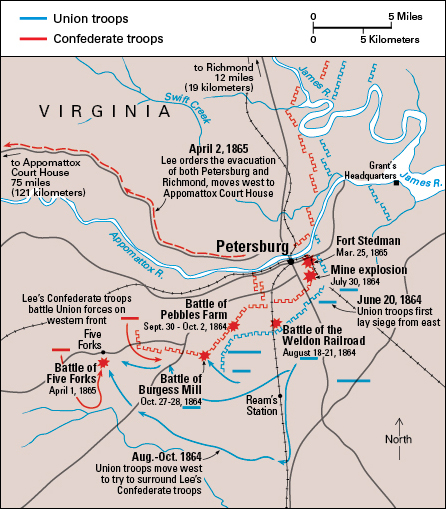Petersburg, Siege of, was an important campaign that led to the end of the American Civil War (1861-1865). The siege, named after the city at the center of the conflict, took place in Virginia from June 1864 to April 1865. Union forces led by General Ulysses S. Grant captured Petersburg on April 3, 1865. On April 9, General Robert E. Lee surrendered his Confederate army. Shortly afterward, the remaining Southern armies also surrendered, and the war ended.
Background.
In May and June 1864, Grant’s Union forces and Lee’s Confederate forces fought a series of bloody battles known as the “Overland Campaign.” At the battles of the Wilderness, Spotsylvania Court House, and the North Anna—all in Virginia—Grant pushed Lee closer to the Confederate capital at Richmond, Virginia. These battles resulted in a large number of casualties for both sides, especially for the Union. On June 3, Union troops charged in a frontal assault on Confederate lines at the Battle of Cold Harbor, just outside Richmond. In less than an hour, the Union suffered several thousand casualties, many of them in the first minutes of the charge.
After Cold Harbor, Grant decided he would try to force Lee’s troops to fight out in the open, away from Richmond. Grant first aimed to capture Petersburg, a city about 25 miles (40 kilometers) south of Richmond. Petersburg was a strategic location because all the railroads that supplied Richmond ran through it. If Grant could seize these railroads and cut off supplies, then he would force Lee to abandon the Confederate capital and fight a final win-or-lose battle. For several days, Lee did not realize Grant’s intentions, and he remained near Cold Harbor with most of his Confederate army.
Missed opportunity.
On June 15, Union General William Smith led 16,000 Union troops toward Petersburg. Confederate General Pierre G. T. Beauregard and his smaller force of about 2,500 men were the only obstacle to Smith’s advance. However, Smith was reluctant to order a direct assault, and he waited until about 7 p.m. to attack. The Union troops quickly defeated the Confederates, and they had an opportunity to capture Petersburg. But instead of taking the city, Smith waited for reinforcements.
For the next three days, the Union army, which still heavily outnumbered the Confederates, launched a series of uncoordinated attacks. Meanwhile, Beauregard pleaded with Lee to send reinforcements. Eventually, Lee realized Grant’s intentions, and he sent his army to reinforce Petersburg on June 17. Lee’s reinforcements arrived the next day, and Grant decided that any further attempts to take Petersburg by a direct assault would fail.
Siege of Petersburg.
On June 20, Grant decided to take Petersburg by siege. He hoped to surround Petersburg and cut off its supplies, forcing Lee’s troops to abandon the city to avoid starvation. The Union and Confederate armies both dug trenches around the city.

Later in June, the Union planned to explode a mine underneath part of the Confederate line and then attack through the gap created by the explosion. Union coal miners from a Pennsylvania regiment built a tunnel more than 500 feet (150 meters) in length and put 4 tons (3.6 metric tons) of gunpowder under the Confederates. On July 30, the mine exploded and created a large crater. But in their attempt to attack the Confederates, the Union troops went into the crater, where they were easy targets for the Confederates. More than 4,000 Union troops were killed, wounded, or captured.
From August to October, in the battles of Weldon Railroad, Peebles Farm, and Burgess Mill, the Union extended the lines west. These battles thinned the Confederate lines, making them easier to pierce, and also cut off some of Petersburg’s supply lines. Because of harsh weather, there was little action during the winter months.
In March 1865, Lee, afraid that his troops would become surrounded, planned a daring attempt to escape Petersburg and join the Confederate army in North Carolina. On March 25, he attacked Union troops on the northeastern end of the lines, at Fort Stedman. The attack was initially successful, but a Union counterattack recaptured the fort and cost Lee about 5,000 men.
Union victory.
On April 2, a Union attack at several points along the lines defeated the Confederates. That night, Lee ordered the evacuation of both Petersburg and Richmond. On April 3, Union troops occupied Petersburg, and the mayor of Richmond surrendered his city.

Lee moved his troops west and surrendered his army to Grant at Appomattox Court House on April 9. Within two months, the rest of the Confederate forces surrendered, and the war was over.
See also Civil War, American; Grant, Ulysses S.; Lee, Robert E.
